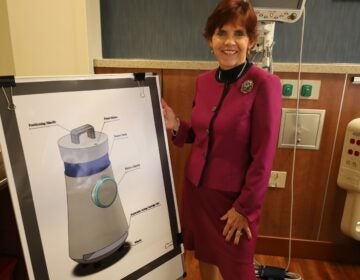9 ways to get healthier in 2024 without trying very hard

Walking, biking or even riding a scooter to get from place to place ups your non-exercise activity thermogenesis, or NEAT. Small movements can make a positive difference to your overall health. (Laura Gao for NPR)
Sometimes trying to be healthy feels like just another item on your endless, exhausting to-do list. Here on NPR’s health team, we don’t want to add to anyone’s stress. The good news is that it doesn’t take great feats of fitness or a heroic commitment to good habits to stay well. Often small changes can make a significant difference.
In 2023, our reporters turned up the latest research on how to stay well without stressing out about it. We highlighted these in our series Living Better, on what it takes to get healthy in America.
Below are some of our best wellness tips from 2023.
1. Get healthier without even going to a gym
Hate the gym? That’s cool. Scientists now say you can get a lot of the health benefits associated with exercise just by increasing how active you are in your daily life. Think of low-effort movements like sweeping the floor, strolling through the grocery aisle, climbing the stairs, bobbing your leg up and down at your desk or stirring the pot while you cook. Researchers have studied this kind of movement and given it the moniker NEAT, which stands for this mouthful: non-exercise activity thermogenesis. Learn how NEAT can keep you healthier and how to get more of it.
2. Flip hunger into satisfaction with this cheap superfood
Weight-loss drugs like Ozempic mimic a hormone that our bodies make naturally to curb food cravings. What if we could increase levels of this hormone (called GLP-1) through our diet? Whether or not we’re trying to lose weight, many of us would like to feel sated longer after we eat and be a little less beholden to our sweet (or salt) tooth.
It turns out that, yes, you can increase satiety hormones by eating more foods with fiber — especially what’s known as fermentable fiber, which is found in foods such as oats, rye, whole wheat and many legumes. Read the full story on your body’s satiety hormones.
Get more health news from NPR
For the latest news on the science of healthy living, click here to subscribe NPR’s weekly health newsletter.
Plus, there’s a host of other reasons to eat more fiber — it helps control blood sugar levels and lower cholesterol and inflammation. And it’s linked to a lower risk of issues like obesity, Type 2 diabetes, cancer and cardiovascular disease. The good news is that foods with fiber are often cheap. And adding more fiber to your meals isn’t as hard as it sounds — we’ve got tips.
3. Little acts of joy can have a big payoff
Small moments add up. From chatting up a stranger, to taking time to reframe a bad day and find the silver lining, to noticing the beauty of nature, science shows that moments like these make a difference to your well-being. Even petting other people’s dogs can give you a boost. The recently launched Big Joy Project from Stanford University is gathering data that shows that we can change our emotional state by embracing these “micro-acts” of happiness.
4. Outsmart dopamine and screens
Over the past few years, neuroscientists have started to better understand what’s going on in our brains when we can’t stop scrolling through social media or stop shopping online, eating junk food or playing video games. These types of activities trigger surges of the neurotransmitter dopamine. And it’s now becoming clear that rather than giving us pleasure, dopamine drives craving, the urge for more. It has a strong, though short-term, hold on our willpower. Understanding how this works can help shift how you manage your own or your kids’ behavior.
Here are four ways to outsmart dopamine and ease off compulsive cravings for screens or sweets.
5. Learn from the Japanese way of life
When NPR’s Yuki Noguchi visited her parents in Japan recently, she logged an average of 6 miles a day running errands with her folks by foot. That’s because Japanese cities are designed for walkability and most people take public transport and walk wherever they need to go. And that’s not all: Fresh food is highly prized there, so even convenience store meals to-go are nutritious and not packed with additives. The country has a “default design” that supports wellness, making healthy choices automatic. It’s not so easy, in many cases, to re-create that in the U.S., but there are ways to adopt parts of the lifestyle — walk whenever you can, choose fresh over packaged — and live more like the Japanese.
6. Combat loneliness through creativity
Loneliness is linked to all kinds of health problems, including increased risk of heart attacks and dementia. And forging new social connections — even with casual acquaintances — can counter that. But how do you break out of an isolated rut?
Jeremy Nobel, a primary care physician and the author of the new book Project UnLonely, has an idea: get artsy. Research shows that making art or even viewing it reduces levels of the stress hormone cortisol and increases levels of the feel-good hormones, like endorphins and oxytocin. In other words, it can put you in a relaxed mood, which can help create an inviting vibe to connect.
And you don’t have to be Picasso; almost any creative act will do, including cooking, gardening, even doodling. Here are five tips from Noble’s new book for how to connect, via creativity.
7. Find a therapist you can afford
You could compare finding a therapist to apartment hunting in a crowded housing market. Demand is high; availability is limited. It requires persistence, flexibility and the knowledge that you may not be able to check every one of your boxes. Some people feel so daunted by the prospect that they give up, especially if they’re trying to find someone who is covered by their insurance or is low cost. At the same time, you may have more options available than you know. Here’s a step-by-step guide to finding a therapist who fits your needs and your budget.
8. Cut back on the ultraprocessed foods in your diet
Read the ingredients list of your favorite packaged snack, and you’ll find some things you’ve surely never stocked in your kitchen pantry, like additives that thicken, emulsify, stabilize or preserve. And that’s not to mention high levels of sugar, fat and sodium. Eating a lot of ultraprocessed foods like sodas, TV dinners and packaged sweets is linked to health problems like Type 2 diabetes and heart disease.
And most of us are likely eating more of these foods than we realize: Ultraprocessed foods make up nearly 60% of what the typical U.S. adult eats and nearly 70% of what kids eat.
So do you need to completely overhaul your family’s diet? Researchers say to start by cutting back. After all, there’s a reason why busy families like packaged foods: They’re convenient, tasty and affordable. So how can you make healthier choices without breaking the bank or cooking late into the night? Start by learning to recognize ultraprocessed foods and then try these easy ways to cut back, plus some smart swaps for kids’ favorite junk foods.
9. Manage back and neck pain
If you suffer from back or neck pain, you probably know that hunching over screens isn’t helping. You might have tried improving your ergonomic setup and posture, but exercise research points to another strategy: taking short spurts of movement throughout the day to release tension and stress in the body.
When the brain senses physical or emotional stress, the body releases hormones that trigger muscles to become guarded and tight. Movement breaks counter that stress response by increasing blood flow to muscles, tendons and ligaments and sending nutrients to the spine.
Here are five exercises to prevent pain, developed by fitness specialists at NASA, an agency where people work in high-stress seated positions.
And sometimes living better with back pain is a matter of making adaptations to how you do the things you love — we’ve got smart hacks for cooking with back pain and adjustments to make so you can get out and garden.
9(MDAzMzI1ODY3MDEyMzkzOTE3NjIxNDg3MQ001))




